CITROEN DS3 CABRIO DAG 2015 Handbook (in English)
Manufacturer: CITROEN, Model Year: 2015, Model line: DS3 CABRIO DAG, Model: CITROEN DS3 CABRIO DAG 2015Pages: 404, PDF Size: 13.93 MB
Page 111 of 404
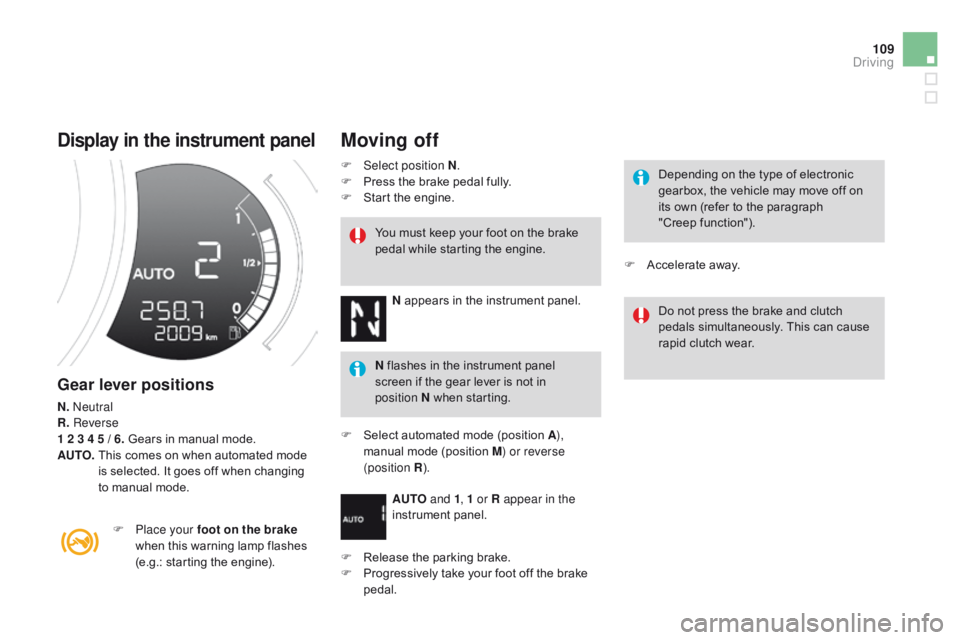
109
DS3_en_Chap06_conduite_ed01-2014
display in the instrument panel
Gear lever positions
N. Neutral
R. Reverse
1 2 3 4 5 / 6. Gears in manual mode.
AUTO.
T
his comes on when automated mode
i
s selected. It goes off when changing
t
o manual mode.
F
P
lace your foot on the brake
when
this warning lamp flashes
(
e.g.: starting the engine).You
must keep your foot on the brake
p
edal while starting the engine.
Moving off
F Select position N
.
F P ress the brake pedal fully.
F
S
tart the engine.
N
appears in the instrument panel.
N
flashes in the instrument panel
s
creen if the gear lever is not in
p
osition
N when starting.
F
S
elect automated mode (position A),
manual
mode (position M) or reverse
(position R ).
AUTO and 1, 1 or R appear in the
instrument
pan
el.
F
R
elease the parking brake.
F
P
rogressively take your foot off the brake
ped
al. Depending
on the type of electronic
g
earbox, the vehicle may move off on
i
ts own (refer to the paragraph
"Creep
function").
Do
not press the brake and clutch
p
edals simultaneously. This can cause
r
apid clutch wear.
F
A
ccelerate away.
driving
Page 112 of 404
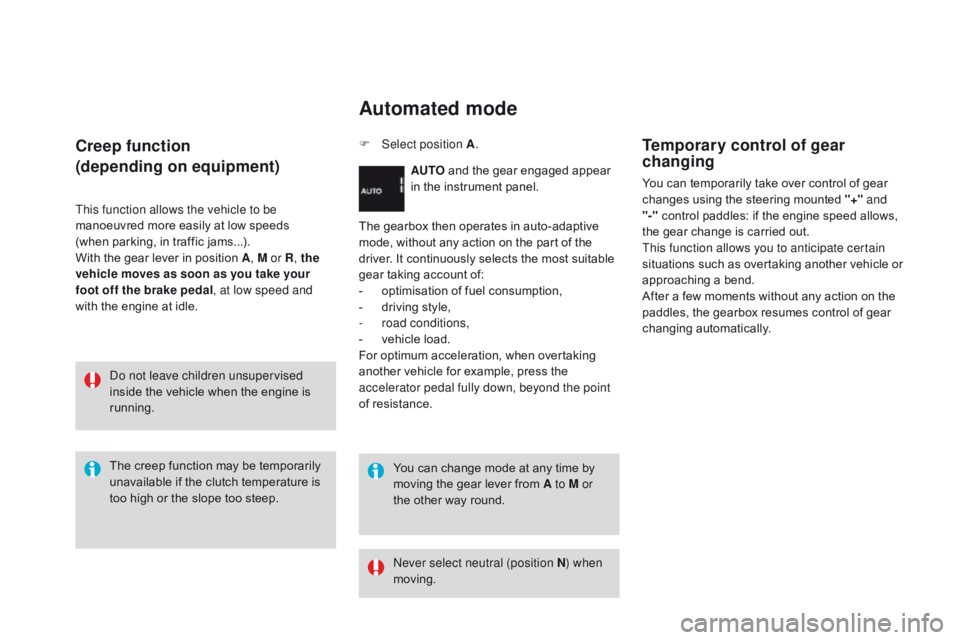
DS3_en_Chap06_conduite_ed01-2014
creep function
(depending on equipment)
This function allows the vehicle to be
manoeuvred more easily at low speeds
(when
parking, in traffic jams...).
With
the gear lever in position A, M or R , the
vehicle moves as soon as you take your
foot off the brake pedal , at low speed and
with
the engine at idle.
Automated mode
AUTO and the gear engaged appear i
n the instrument panel.
The
gearbox then operates in auto-adaptive
m
ode,
without any action on the part of the
d
river.
It
continuously selects the most suitable
g
ear
taking account of:
-
o
ptimisation of fuel consumption,
-
d
riving style,
-
r
oad conditions,
-
v
ehicle load.
For
optimum acceleration, when overtaking
a
nother
vehicle for example, press the
a
ccelerator pedal fully down, beyond the point
of
resistance. You
can change mode at any time by
m
oving the gear lever from A to M or
the
other way round.
The
creep
function
may
be
temporarily
u
navailable
if
the
clutch
temperature
is
t
oo
high
or
the
slope
too
steep.
Do not leave children unsupervised
inside
the
vehicle
when
the
engine
is
r
unning. F
Sel
ect position A
.
Never select neutral (position N ) when
moving.
Temporary control of gear
changing
You can temporarily take over control of gear c hanges using the steering mounted "+" and
"-"
control paddles: if the engine speed allows,
t
he gear change is carried out.
This function allows you to anticipate certain
situations
s
uch
a
s
ov
ertaking
a
nother
v
ehicle
o
r
a
pproaching a bend.
After
a few moments without any action on the
p
addles, the gearbox resumes control of gear
c
hanging
a
utomatically.
Page 113 of 404
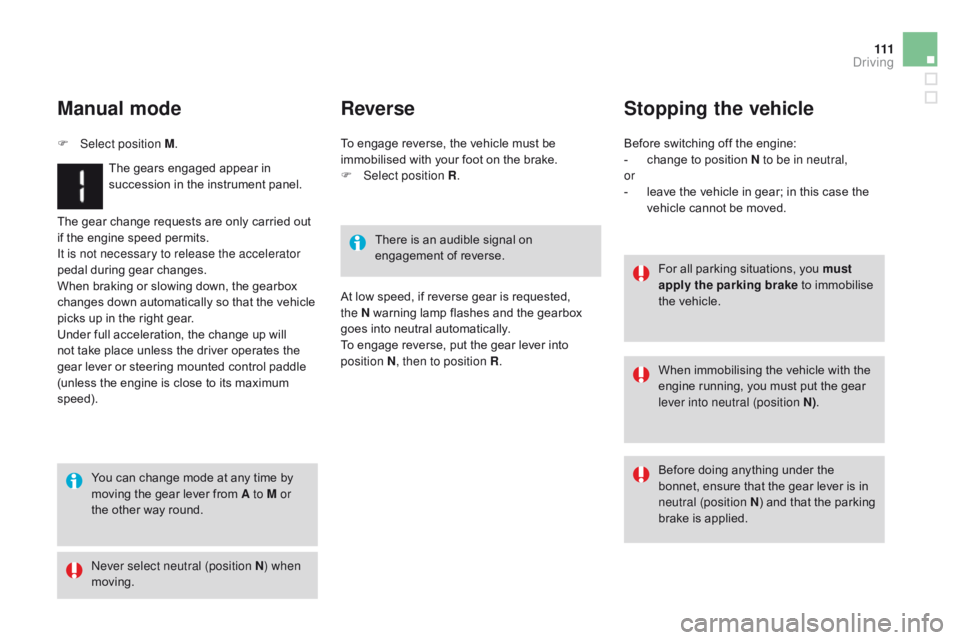
111
DS3_en_Chap06_conduite_ed01-2014
The gear change requests are only carried out if the engine speed permits.
It is not necessary to release the accelerator
pedal
during gear changes.
When
braking or slowing down, the gearbox
c
hanges down automatically so that the vehicle
p
icks up in the right gear.
Under
full acceleration, the change up will
n
ot take place unless the driver operates the
g
ear lever or steering mounted control paddle
(
unless the engine is close to its maximum
s
peed).
Reverse
To engage reverse, the vehicle must be immobilised with your foot on the brake.
F
Sel
ect position R .
Stopping the vehicle
Before switching off the engine:
- c hange to position N to be in neutral,
or
-
l
eave the vehicle in gear; in this case the
v
ehicle cannot be moved.
Manual mode
F Select position M.
The gears engaged appear in
s
uccession in the instrument panel.
You
can change mode at any time by
m
oving the gear lever from A to M or
the
other way round.
Never select neutral (position N ) when
moving. There
is an audible signal on
enga
gement
o
f
r
everse.For
all parking situations, you must
apply the parking brake
to immobilise
t
he vehicle.
When
immobilising the vehicle with the
e
ngine running, you must put the gear
l
ever into neutral (position N).
Before
doing anything under the
b
onnet, ensure that the gear lever is in
neu
tral (position N)
and that the parking
b
rake is applied.
At
low speed, if reverse gear is requested,
the N
warning lamp flashes and the gearbox
g
oes into neutral automatically.
To
engage reverse, put the gear lever into
p
osition N, then to position R .
driving
Page 114 of 404
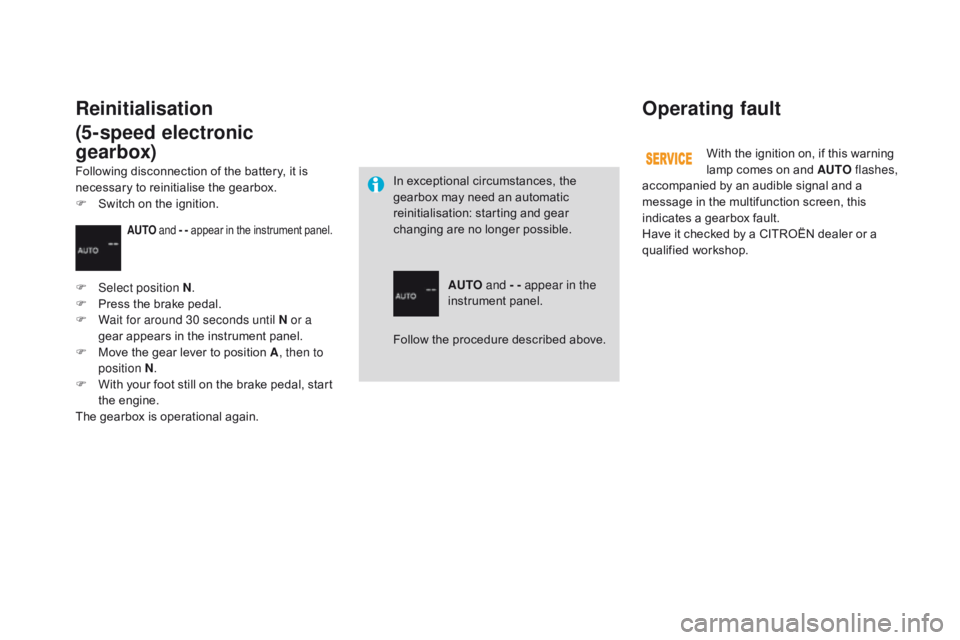
DS3_en_Chap06_conduite_ed01-2014
Operating fault
With the ignition on, if this warning lamp comes on and AUTO flashes,
accompanied
by an audible signal and a
m
essage
in
the multifunction screen, this
i
ndicates
a
gearbox fault.
Have
it
checked by a CITROËN dealer or a
q
ualified
w
orkshop.
Reinitialisation
(5-speed electronic
gearbox)
In exceptional circumstances, the g earbox may need an automatic
r
einitialisation: starting and gear
c
hanging are no longer possible.
AUTO and - - appear in the
instrument
pan
el.
AUTO and - - appear in the instrument panel.
F Select position N.
F P ress the brake pedal.
F
W
ait for around 30 seconds until N or a
gear
appears in the instrument panel.
F
M
ove the gear lever to position A, then to
position N .
F
W
ith your foot still on the brake pedal, start
t
he
eng
ine.
The
gearbox is operational again.
Following
disconnection of the battery, it is
n
ecessary to reinitialise the gearbox.
F
S
witch on the ignition.
Follow the procedure described above.
Page 115 of 404
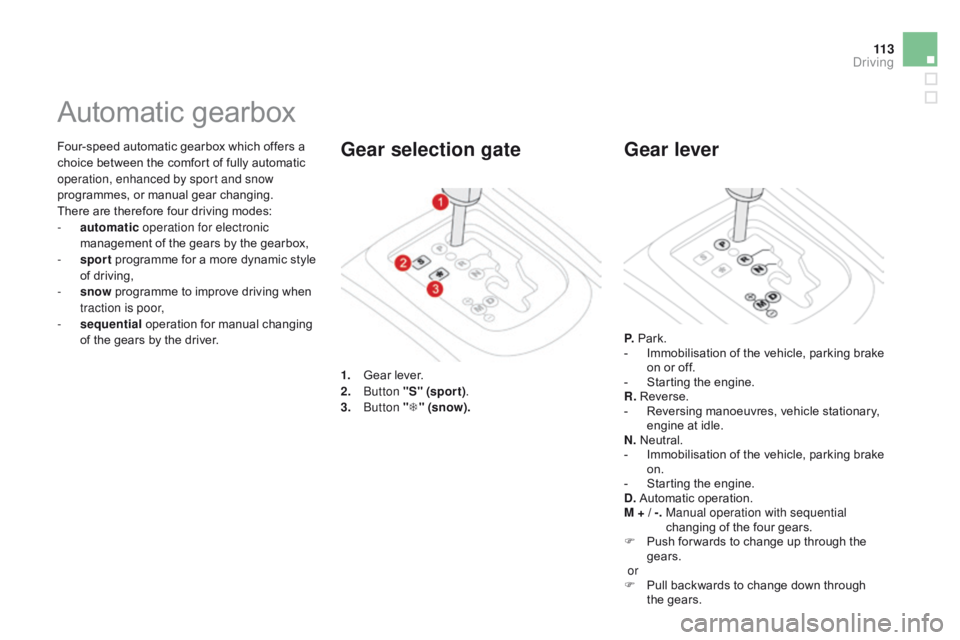
11 3
DS3_en_Chap06_conduite_ed01-2014
Four-speed automatic gearbox which offers a choice between the comfort of fully automatic
o
peration, enhanced by sport and snow
programmes,
o
r
m
anual
g
ear
c
hanging.
There
are therefore four driving modes:
-
a
utomatic operation for electronic
management
of the gears by the gearbox,
-
sp
ort
programme for a more dynamic style
o
f driving,
-
s
now
programme to improve driving when
t
raction is poor,
-
s
equential
operation for manual changing
o
f the gears by the driver.
Automatic gearbox
1. Gear lever.
2. bu tton "S" (spor t) .
3.
bu
tton "T " (snow).
Gear selection gate
P. Park.
- I mmobilisation of the vehicle, parking brake
o
n or off.
-
S
tarting the engine.
R.
R
everse.
-
R
eversing manoeuvres, vehicle stationary,
e
ngine at idle.
N.
Neutral.
-
I
mmobilisation of the vehicle, parking brake
o
n.
-
S
tarting the engine.
d
.
A
utomatic
ope
ration.
M + / -.
M
anual operation with sequential
changing
of the four gears.
F
P
ush for wards to change up through the
g
ears.
or
F
P
ull backwards to change down through
t
he gears.
Gear lever
driving
Page 116 of 404
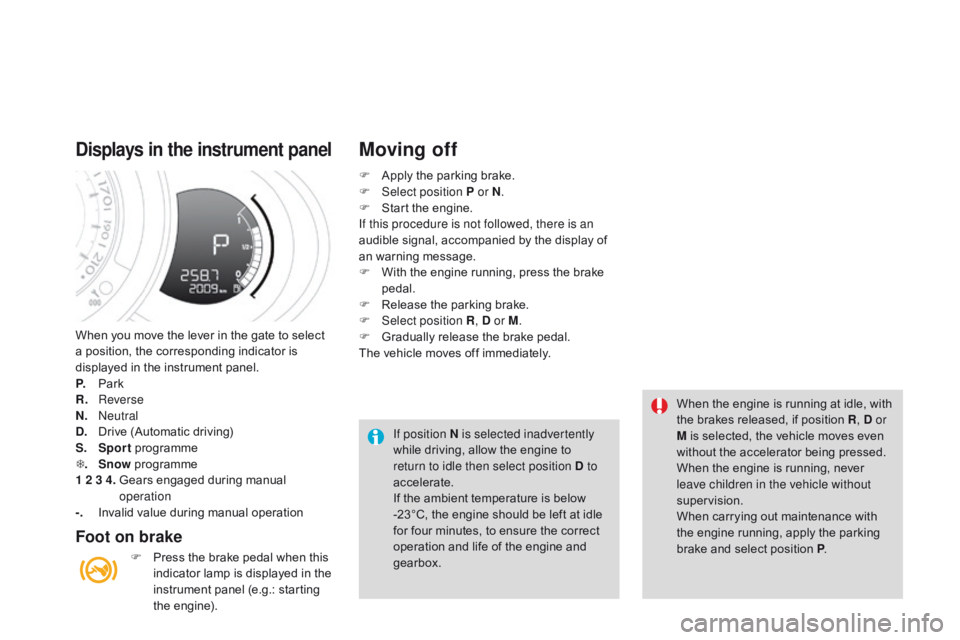
DS3_en_Chap06_conduite_ed01-2014
When you move the lever in the gate to select a position, the corresponding indicator is
d
isplayed in the instrument panel.
P.
Pa
rk
R.
R
everse
N.
N
eutral
d
.
D
rive (Automatic driving)
S.
Sport
pro
gramme
T .
Snow
pro
gramme
1 2 3 4.
G
ears engaged during manual
ope
ration
-.
I
nvalid value during manual operation
displays in the instrument panel
Foot on brake
F Press the brake pedal when this i
ndicator lamp is displayed in the
i
nstrument panel (e.g.: starting
t
he
eng
ine).
Moving off
If position N is selected inadvertently
while driving, allow the engine to
r
eturn to idle then select position d to
accelerate.
If
the ambient temperature is below
-
23°C, the engine should be left at idle
f
or four minutes, to ensure the correct
o
peration and life of the engine and
g
earbox. When
the engine is running at idle, with t
he brakes released, if position R
, d or
M is selected, the vehicle moves even
w
ithout the accelerator being pressed.
When
the engine is running, never
l
eave children in the vehicle without
supervision.
When
carrying out maintenance with
t
he engine running, apply the parking
b
rake and select position P.
F
A
pply the parking brake.
F
Sel
ect position P or N
.
F
S
tart the engine.
If this procedure is not followed, there is an
audible signal, accompanied by the display of
a
n
warning message.
F
W
ith the engine running, press the brake
ped
al.
F
R
elease the parking brake.
F
Sel
ect position R
, d or M
.
F
G
radually release the brake pedal.
The
vehicle moves off immediately.
Page 117 of 404
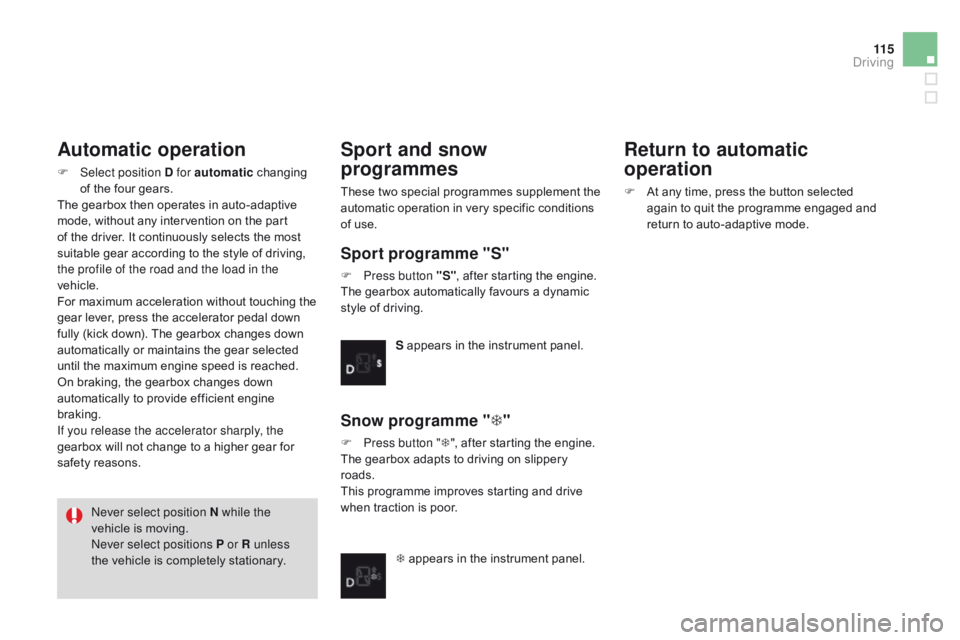
11 5
DS3_en_Chap06_conduite_ed01-2014
Automatic operation
F Select position d for automatic c hanging o
f the four gears.
The
gearbox then operates in auto-adaptive
m
ode, without any intervention on the part
o
f the driver. It continuously selects the most
s
uitable gear according to the style of driving,
t
he profile of the road and the load in the
vehicle.
For
maximum acceleration without touching the
g
ear lever, press the accelerator pedal down
f
ully (kick down). The gearbox changes down
a
utomatically or maintains the gear selected
u
ntil the maximum engine speed is reached.
On
braking, the gearbox changes down
a
utomatically to provide efficient engine
b
raking.
If you release the accelerator sharply, the
gearbox
will not change to a higher gear for
s
afety reasons.
Never select position N while the
vehicle
is moving.
Never select positions P or R unless
the
vehicle is completely stationary.
Sport and snow
programmes
These two special programmes supplement the automatic operation in very specific conditions
o
f use.
Sport programme "S"
F Press button "S" , after starting the engine.
The gearbox automatically favours a dynamic
s
tyle of driving.
S
appears in the instrument panel.
Snow programme "T"
F Press button " T", after starting the engine.
The gearbox adapts to driving on slippery
r
oads.
This
programme improves starting and drive
w
hen traction is poor.
T
appears in the instrument panel.
Return to automatic
operation
F At any time, press the button selected a
gain to quit the programme engaged and
r
eturn to auto-adaptive mode.
driving
Page 118 of 404

DS3_en_Chap06_conduite_ed01-2014
There is a risk of damage to the gearbox:
- i f you press the accelerator and
brake
pedals at the same time,
-
i
f you force the movement of the
g
ear lever from the P position to
another position when the battery
is
flat.
To
reduce fuel consumption when at
a
prolonged standstill with the engine
r
unning (traffic jam...), put the gear lever in
t
he N
position and apply the parking brake.
If the lever is not in position P
,
when the driver's door is opened or
approximately
45
seconds
after
the
i
gnition
is
switched
off,
a
warning
m
essage
appears
in
the
screen.
F
R
eturn the lever to position P ;
the
m
essage
d
isappears.
When
driving
on
flooded
roads
or
when
c
rossing
a
ford,
proceed
at
walking
p
ace.
Operating fault
Manual operation
When the ignition is on, the lighting o f this warning lamp, accompanied
b
y
an
audible signal and a message in the
m
ultifunction screen, indicates a gearbox fault.
In
this
case, the gearbox switches to back-up
m
ode
and
is locked in 3rd gear. You may feel
a
substantial knock when changing from P
to R
and
from N to R .
This will not cause any
d
amage
to
the gearbox.
Do
not
exceed 60 mph (100 km/h), local speed
r
estrictions
p
ermitting.
Contact a CITR
oË
N dealer or a qualified
workshop
as soon as possible.
F
Sel
ect position M for sequential
c
hanging
o
f
the
four
gears.
F
P
ush the lever towards the +
sign
to
c
hange
up
a
gear.
F
P
ull the lever towards the -
sign
to
change
d
own
a
gear.
It
is
only
possible
to
change
from
one
gear
to
a
nother
if
the
vehicle
speed
and
engine
speed
p
ermit;
other wise,
the
gearbox
will
operate
t
emporarily
in
automatic
mode. This
symbol
is
displayed
if
a
gear
i
s
not
engaged
correctly
(selector
b
etween
two
positions).
d
disappears
and
the
gears
e
ngaged
appear
in
succession
in
the
in
strument
pan
el.
Stopping the vehicle
Before switching off the engine, you can engage p osition P or N
to place the gearbox in neutral.
In
both cases, apply the parking brake to
i
mmobilise the vehicle.
Invalid value during manual
operation
If the engine speed is too low or too high, the gear selected flashes for a few seconds, then
t
he actual gear engaged is displayed.
It
is possible to change from position d
(automatic)
to position M (manual) at any time.
When
the vehicle is stationary or moving
v
ery slowly, the gearbox selects gear M1
automatically.
The
sport and snow programmes do not
o
perate in manual mode.
Page 119 of 404
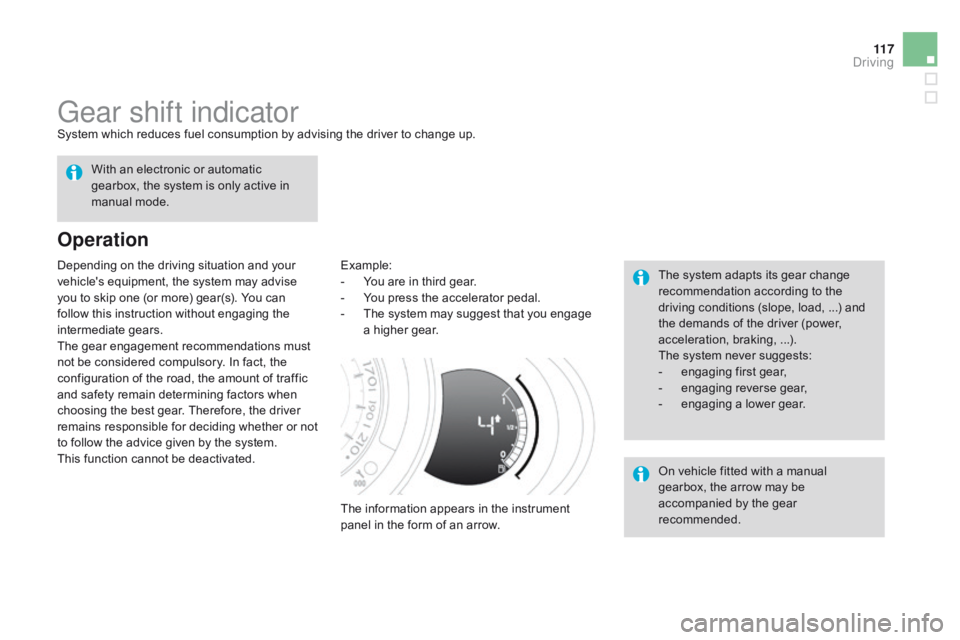
11 7
DS3_en_Chap06_conduite_ed01-2014
Gear shift indicatorSystem which reduces fuel consumption by advising the driver to change up.
Operation
Example:
- Y ou are in third gear.
-
Y
ou press the accelerator pedal.
-
T
he system may suggest that you engage
a
higher gear.
The
information appears in the instrument
p
anel in the form of an arrow. The
system adapts its gear change
r
ecommendation according to the
d
riving conditions (slope, load, ...) and
t
he demands of the driver (power,
a
cceleration, braking, ...).
The
system never suggests:
-
e
ngaging first gear,
-
enga
ging
r
everse
g
ear,
-
e
ngaging a lower gear.
With
an
electronic
or
automatic
g
earbox,
the
system
is
only
active
in
m
anual
m
ode.
On vehicle fitted with a manual
g
earbox, the arrow may be
a
ccompanied by the gear
re
commended.
Depending
on
the
driving
situation
and
your
v
ehicle's
equipment,
the
system
may
advise
y
ou
to
skip
one
(or
more)
gear(s).
You
can
f
ollow
this
instruction
without
engaging
the
i
ntermediate
g
ears.
The
gear
engagement
recommendations
must
n
ot
be
considered
compulsory.
In
fact,
the
c
onfiguration
of
the
road,
the
amount
of
traffic
a
nd
safety
remain
determining
factors
when
c
hoosing
the
best
gear.
Therefore,
the
driver
r
emains
responsible
for
deciding
whether
or
not
t
o
follow
the
advice
given
by
the
system.
This
function
cannot
be
deactivated.
driving
Page 120 of 404

DS3_en_Chap06_conduite_ed01-2014
Stop & StartThe Stop & Start system puts the engine temporarily into standby - STOP mode - during stops in the traffic (red lights, traffic jams, or other...). The engine restarts automatically - START mode - as soon as you want to move off. The restart takes place instantly, quickly and silently.
Per fect
for urban use, the Stop & Start system reduces fuel consumption and exhaust emissions as well as the noise level when stationary.
Operation
Going into engine STOP mode
For your comfort, during parking manoeuvres, STOP mode is not
a
vailable for a few seconds after
coming
out of reverse gear.
STOP
mode does not affect the
f
unctionality of the vehicle, such as for
example,
braking, power steering...
Never
refuel with the engine in STOP
m
ode; you must switch off the ignition
w
ith the key.
The "E
cO
"
warning
lamp
comes
o
n
in
the
instrument
panel
and
the
e
ngine
goes
into
standby:
-
w
ith a manual gearbox , at speeds below
12
mph
(20
km/h),
when
you
put
the
gear
l
ever into neutral, and you release the
clutch
pedal.
-
w
ith a 5 or 6-speed electronic gearbox ,
when
stationary
or
at
speeds
below
5
mph
(
8
km/h)
(depending
on
version),
when
you
p
ress
the
brake
pedal
or
put
the
gear
lever
i
n position N .
A
time
counter
calculates
the
sum
o
f
the
periods
in
STOP
mode
d
uring
a
journey.
It
rests
itself
t
o
zero
every
time
the
ignition
is
s
witched
on
with
the
key. STOP
mode is not invoked when:
- t he driver's door is open,
-
t
he driver's seat belt is not fastened,
-
t
he vehicle has not exceeded 6 mph
(10
km/h) since the last engine start using
t
he key,
-
t
he engine is needed to maintain a
c
omfortable temperature in the passenger
c
ompartment,
-
d
emisting is active,
-
s
ome special conditions (battery charge,
e
ngine temperature, braking assistance,
a
mbient temperature...) where the engine is
n
eeded to assure control of a system.
Special cases: STOP mode not
available
The "EcO" warning lamp flashes for a
few seconds then goes off.
This operation is perfectly normal.